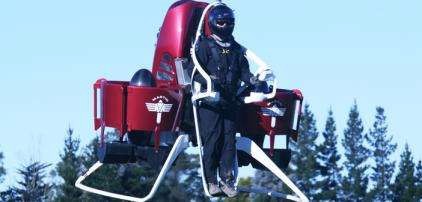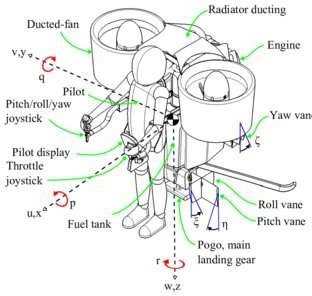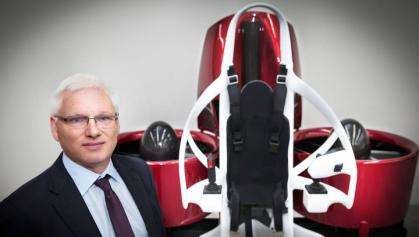Glenn Martin ZL3MTH guest speaker at the branch general meeting.
Wednesday 7th April 2021.
Jet-packs; who doesn’t want one ? They’ve been depicted in comic books since the 1920’s, and then featured as special effects on science fiction TV shows, like Lost In Space in the 1960’s. By the 1960’s genuine Jetpacks did exist, but running on Hydrogen Peroxide Rocket Fuel and with a flight time of less than 30 seconds, they were really just prototypes available at huge cost to the military.
A Jet-pack even turned up at the 1984 Los Angeles Olympics opening ceremony. Flight time, less than a minute, cost about a zillion dollars. Glenn Neal Martin (not to be confused with other Glenns and other Martins, some also involved in aviation over the years), was at Otago University in 1981 studying Biological Sciences, when he got bitten by the Jet-pack bug and wanted to make them much more affordable and with a usefully useable flight-time, instead of the piddly few seconds then available.
The Science department started off as sessions in the students’ local watering hole, Dunedin’s Captain Cook Hotel, and Glenn’s Martin Jet- pack funding started at $20 worth of 5 cent coins for the University Library photocopier.
He transferred to Canterbury University’s Engineering Department and things, you could say, “took off” from there.Starting out, in his garage (like ALL good Kiwi inventors !), his first test unit had no stability control, so it simply ran up and down a vertical pole. His wife, (Mrs Martin ? I’m guessin’ she’s got a first name, but I don’t know it), being the first test subject, making her the very first test pilot of The Martin Jet-pack (a coup for anyone’s C.V.). No worries, things are all sweet there.
As the Ducted Fan design developed and improved and with improvements to the initially crude, stability control in place, one of their young adult children was voted in as test-pilot. With some trepidation, Glenn’s wife asked if, in the event of a crash their son would live. “He’ll be fine, no more than a broken leg or two” he replied (well words to that effect, this is my recollection of Glenn’s talk).
No legs were broken and although the Martin Jet-pack would be improving in both stability and performance, learning to fly those early versions was akin to putting an adult who couldn’t ride at all, on a bicycle for the first time. And just like adults can learn in a few hours, the basics of riding a bike, once past the novice stage, controlling the Martin Jet-pack wasn’t too hard.
Right from the beginning, Glenn had kept the parameters that allowed this to fall under Ultralight rules in the FAA (US Federal Aviation Authority, rules part 103). So that’s 62 mph maximum speed, 5 US gallons of gasoline/petrol fuel and 254 pounds aircraft weight.

By 2007 they ran the papers through for the US Patents and it was one of the three most anticipated exhibits scheduled to appear at the 2008 Airventures Airshow in Oshkosh, Wisconsin USA.
Oshkosh has been running since 1953 and has 750,000 visitors, with 10,000 private planes arriving, 4,000 exhibitors on site and 700 official media representatives from around the world. The event launch was the biggest ever since the airshow began. Bigwigs from the US Military and the Pentagon are always hovering around.
The Martin Jet-pack was effectively propelled to the front of the pack. Indeed when arriving at the location, and seeing massive crowds as far as the eye can see, Glenn commented to his wife about the size of the audience to see the other exhibits and displays.
“They’re here to see The Jet-pack and YOU ya bozo !” she said (or, words to that effect).
Within one day, there were 970 TV news articles and interviews about the Martin Jetpack, with Glenn, his wife and a couple of assistants getting little sleep as they were trying to wrangle interview timeslots in timezones around the world. On their way back out of the USA they stopped off in Los Angeles and were interviewed on both US mainstay TV shows, being Jay Leno and David Letterman. One of their sons was just 13-years-old at the time and those shows are rated R16, so he was supposed to stay backstage (in the Green Room), not counting that he found his way onstage for awhile, and teamed up unofficially with the comedian going through a warm-up event with the audience beforehand.

After the public exposure at Oshkosh, many opportunities opened up. A much improved stability control system was obtained for $5,000 (discounted from the almost $500,000 original development cost budgeted by the US military). Improved stability control would mean later evolutions of the Jet-pack could be piloted by pretty much any adult, after just a short session of training using a VR computer gaming style headset.
Glenn made the point that all the folks that worked at Martin, got a go using the Jetpack. Even the secretary. Like most small companies it was lean, and efficient while small. Their designs were being constantly improved and updated and for minimal costs. However more funds were needed for a proper expansion.
They looked at listing on the NZ Stock Exchange. But the reply from the dudes there was something to the effect of “Get on ya bike !”. So bike they did, all the way across the Big Ditch to Australia. They listed on the ASX in early 2015.
The listing price of the IPO (Initial Public Offering) was some $40 per share. By the end of the first day, it had settled around $44 (a good result, which few IPOs manage to match). Within a year, the share price had risen to almost $400 per share.
Initially Glenn’s funding had come from, as he called it, “the three effs” (Family, Friends, and Fools), helping fund him as best they could. That doesn’t even count the long days and his own “grey hair” count, he reckoned.
As the share price rose, Glenn told of an early investor who had risked $65,000 (a sizeable sum back when she first invested and likely enough to have bought at least one entire house in Dunedin back then). He received a phone call (as his Friend ? Certainly no Fool) detailed how by redeeming her initial investment, she’d been able to pay off her own house mortgage, plus the home and student loans of a number of her relatives and still had $5 million left over.
Somewhere along the way, a Hong Kong Chinese company (effectively Chinese Government controlled) had ended up with 52% of the shares and a controlling interest. The Martin Jet-pack company has now gone totally byebye, and doesn’t exist as such, but the Chinese still have the patents locked up until about 2032.
Glenn reckons there’s many companies still working on their own “Jet- pack” projects (he’s consulted on a few of them) that don’t rely on those patents, so perhaps there’s a chance for the public to experience personal jetpacks in my lifetime, yet.
Thanks so much to Glenn N. Martin for his guest speech, and to his wife and kids for their essential assistance as his assistants right from the beginning of his amazing Martin Jet-pack adventure.
Author Catherine ZL3CATH


